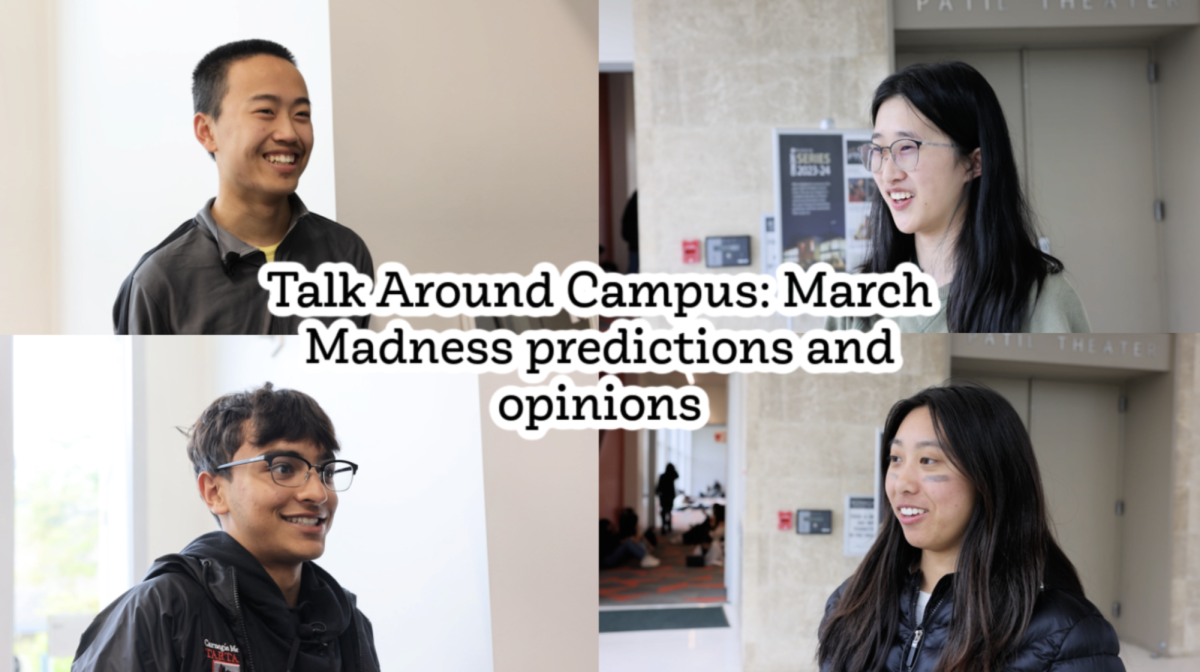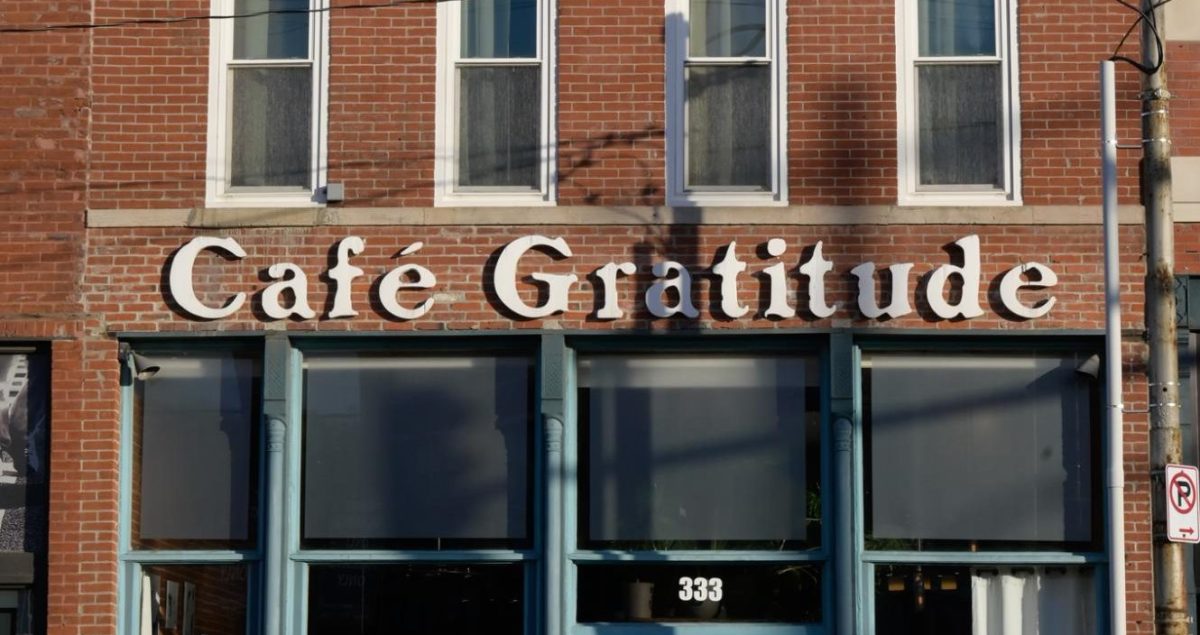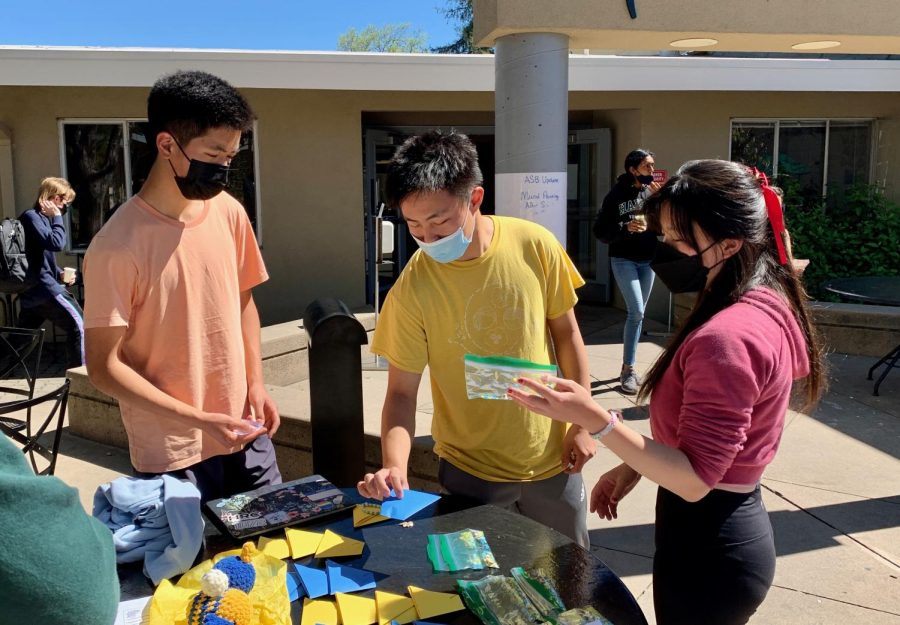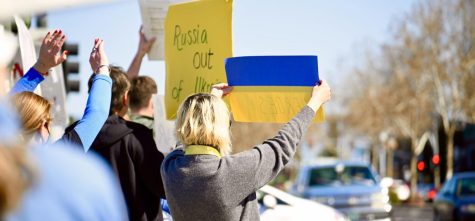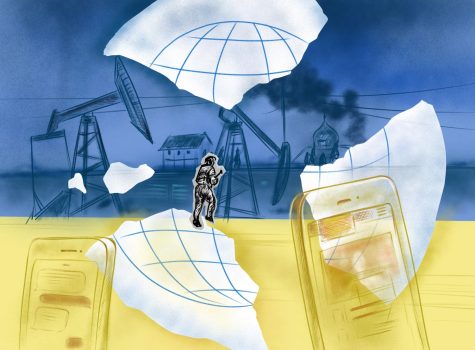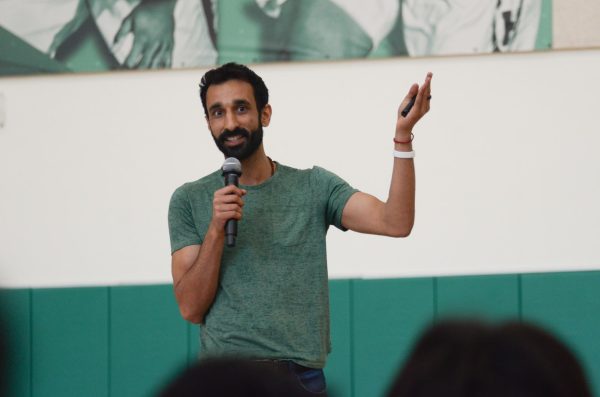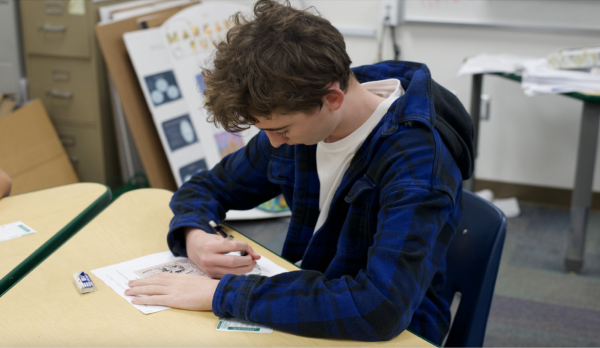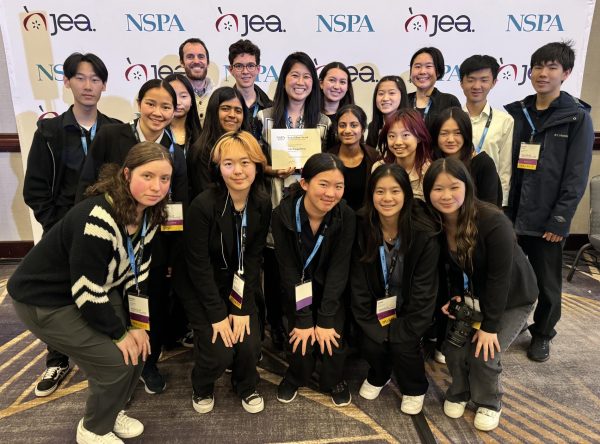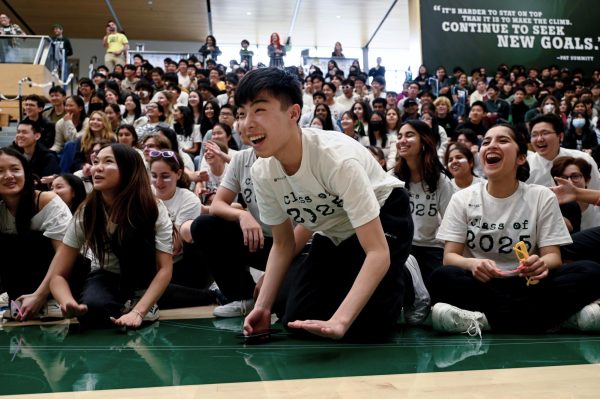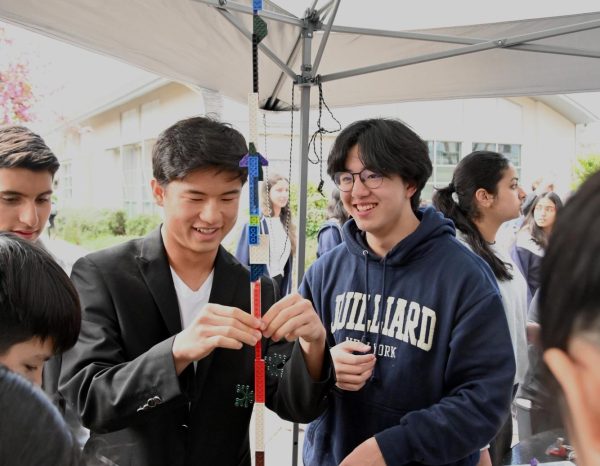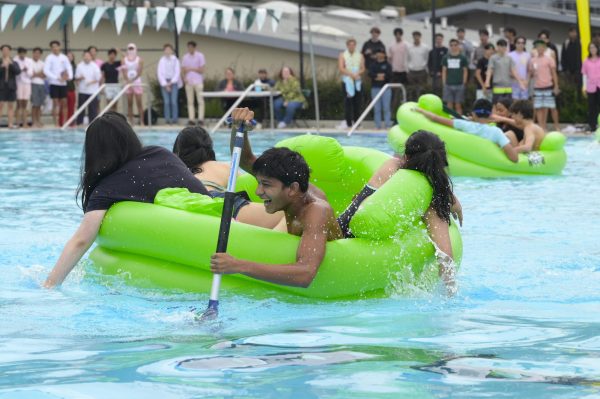Ukraine FAQ: Current situation, major players, ways to help
Brian Chen (11), Kevin Wang (12) and Alice Feng (12) stand by Research Club and Medical Club’s fundraiser during lunch on Tuesday. Various organizations held fundraisers to raise money for the UN Refugee Agency.
This is a developing story. Check harkeraquila.com for continuous updates on the development of the Russian-Ukrainian conflict.
1. What’s the current situation in Ukraine, and what has led up to it?
Russia launched a full-scale invasion of Ukraine on Feb. 24, moving into the country from their shared border and using bomb campaigns to slowly surround the capital city of Kyiv, with the ultimate goal of capturing it. On March 2, Russian defense ministry spokesman Igor Konashenkov said that Russian forces had taken “full control” of the tactical asset of Kherson, a southern port city. Cities in eastern Ukraine like Kharkiv and Mariupol have fallen. As of March 15, according to the U.N, 691 civilians have been killed and 1,143 more have been injured since Russia’s invasion more than two weeks ago.
The crisis marks the latest development in the ongoing Russo-Ukrainian war that began in early 2014 with Russia annexing the Ukrainian territory of Crimea. The buildup to the invasion expressed itself most clearly beginning in fall 2021: when President Alexander Lukashenko of Belarus opened floodgates of Russian immigrants passing through Belarus to overwhelm nearby EU countries like Poland, a U.S. State Department official feared feared on Jan. 18 that Belarus was supporting Russia’s invasion by drawing European attention away from Ukraine.
“In order to deflect attention from a domestic political crisis and in an effort to garner international attention, Lukashenk[o] and the region manufactured a migrant crisis,” the official said.
The United States began to monitor Russia’s mobilization of forces near Ukraine early this year and confirmed suspicions that Russia was gearing up to invade.
“The Russian Federation has amassed upwards, at this time, of over 100,000 ground forces, air forces, naval forces, special forces, cyber, electronic warfare, command and control, logistics, engineers and other capabilities along the Ukraine border,” said Mark Millay, Chairman of the Joint Chiefs of Staff, in a Jan. 28 press conference.
In a speech on Feb. 21, Putin recognized the autonomy of Donetsk and Luhansk, two Ukrainian oblasts, or regions, that are part of the contested Donbass region. Putin’s declaration further incited Russian nationalists residing there to begin skirmishes. By Feb. 24, Russia escalated these separatist tensions into full-scale war with bomb campaigns targeting the capital.
2. What is Russia’s motivation for moving into Ukraine?
Since the end of the end of the Cold War in 1990, the North Atlantic Treaty Organization (NATO) has been steadily expanding eastward. As an alliance formed between countries in Europe and North America, NATO serves to ensure the freedom and political security of its members. In 2004, NATO added seven former Soviet satellite states as members in its fifth and largest expansion to date. In 2008, the alliance welcomed Ukraine’s application for membership and stated that the country would eventually become a member without providing a specific timeline.
According to AP News, Putin has demanded that NATO stop its eastward expansion, claiming that any further expansion would pose a security threat towards Russia. In the weeks leading up to NATO’s summit in 2008, Putin warned U.S diplomats that steps to bring Ukraine into the alliance “would be a hostile act toward Russia.” Ukraine, in opposition, has remained determined in its stance to further diplomatic relations with western Europe.
“If we cannot enter NATO’s “open door”, then we must work with communities available, communities that will help us,” Zelenskyy said in a meeting with the Joint Expeditionary Force.
In recent weeks, Putin perpetuated his dim view of NATO as a threat to Russia.
“In territories adjacent to Russia a hostile ‘anti-Russia’ is taking shape,” Putin said in his declaration of war speech on Feb. 24. “The leading NATO countries are supporting the far-right nationalists and neo-Nazis in Ukraine, those who will never forgive the people of Crimea and Sevastopol for freely making a choice to reunite with Russia.”
Putin claimed that the objective of his “special military operation” was to “demilitari[z]e and denazify Ukraine” and to protect Russian citizens subjected to “humiliation and genocide perpetrated by the Kyev regime.”
3. What is the Ukrainian response to the invasion?
According to the UN High Commissioner for Refugees, 50,000 Ukrainians fled the country within the first 48 hours of the invasion. Individuals who remain have used makeshift weapons and words to slow and oppose the Russian military’s progress.
President Volodymyr Zelenskyy has encouraged the military and civilians to take up arms as Russian campaigns progress into Ukraine. He released a statement on Monday recognizing the civilians’ efforts as “strong support for the Armed Forces . . . [and a] sincere volunteer movement.”
The government has taken steps to strike back at Russia and protect its citizens.
In a Twitter exchange, Ukrainian Vice Prime Minister Mykhailo Fedorov successfully procured terminals for Starlink, a satellite communication service, from SpaceX founder and CEO Elon Musk. The satellites have allowed Ukrainian residents to stay connected to friends, family and credible news sources rather than the Russian narrative spreading that justifies the invasion.
Fedorov also tweeted a letter to Apple CEO Tim Cook requesting the conglomerate shut down its Apple Store locations and block Apple products in Russia in order to “do everything possible to protect Ukraine, Europe, and finally, the entire world from bloody authoritarian aggression.”
On March 10, the Ukrainian Embassy in Washington, D.C. put out a call for volunteer soldiers to bolster Ukraine’s 200,000 active troops to face the 850,000 Russia possesses.
A humanitarian crisis has emerged as the invasion continues to intensify. According to the Ukrainian Refugee Agency (UNHCR), as of March 16, over 3.7 million refugees have fled from Ukraine since the invasion began on Feb. 24.
Along with many other humanitarian organizations, the Red Cross is also providing humanitarian aid to refugees on the move, delivering food, medical supplies, household items and more, as well as assisting with the evacuation of people with disabilities.
4. What’s the historical context for this conflict?
Ukraine has long played an important role in the global security order. As a satellite state of the Union of Soviet Socialist Republics (USSR), Ukraine and its fertile farms supplied one-fourth of the Soviet grain supply. In 1954, Soviet Statesman Nikita Khrushchev formally transferred the region of Crimea from Russian control to the Ukrainian Soviet Republic.
The political, economic and cultural bonds between Ukraine and Russia run centuries deep, exacerbating a schism within Ukraine after the 1991 dissolution of the USSR. While the more nationalist Ukrainian-speaking population wanted greater integration with Europe, Russian-speaking nationalists in the eastern regions of the country wanted closer ties to Russia, including supporting Russia since 2013 in a fight for occupation of the coal-rich eastern Ukrainian region of Donbass.
Since its independence, Ukraine has sought to build its power as a sovereign state while becoming closer with Western powers such as the European Union and NATO.
In 2014, Russia invaded and illegally annexed Ukraine’s Crimean peninsula, marking the first time since World War II that a European state illegally took possession of another state’s territory. The ensuing tensions between the two countries culminated in this year’s conflict.
5. What is the U.S’s involvement in this situation?
Russia’s move received swift condemnation from the Biden administration. In an official statement from Oct. 5, 2021, the White House stated, “The United States supports Ukraine’s sovereignty and territorial integrity within its internationally recognized borders and promotes the implementation of domestic reforms.” Since Ukraine’s independence in 1999 and the 2014 annexation of Crimea, Ukraine has been a close ally of the U.S. and received $679 million of aid, the most the U.S. has given to a country in the eastern European region, from 2021-2022.
On Feb. 25, one day after the full-scale invasion began, the United States imposed sanctions to block all assets in American possession of Russian President Vladimir Putin, Minister of Foreign Affairs Sergei Lavrov and other members of the Russian Security Council. Sanctions on Russian banks and exports followed. The sanctions have been potent in harming the Russian economy, slashing the value of the ruble by 30%, according to AP News.
White House Press Secretary Jen Psaki announced Tuesday that President Biden will travel to Brussels, Belgium for a March 24 summit with NATO allies about addressing the developing situation in Ukraine.
6. What’s the stance of other countries? Which countries support each side?
According to a translated tweet from a Russian media outlet, Moscow has issued a list of countries they perceive to be taking “unfriendly actions” against them; the list spanned European Union (EU) Member States and Great Britain to Taiwan and Japan. However, not all of these countries have directly condemned the Kremlin. U.S. President Biden has demurred from putting American troops in Ukraine; he has instead moved 70,000 troops to Germany to bolster the NATO presence going into Ukraine, which is not a NATO member state.
Most members of the international community have imposed economic sanctions on Russia, raising concerns that Russia will in retaliation slow exports of oil and natural gas, and gas prices have already surged to an all-time high. A gallon of gas now costs $5.97 in San Francisco and $5.85 in Santa Clara. A month ago, a gallon cost a national average of $3.51 in comparison.
Some countries are slower to condemn Russia. While Russia’s close ally Serbia acknowledged the “territorial integrity” of Ukraine, the country explicitly refused in a UN Security Council Resolution to impose sanctions to reciprocate how Russia was the only European country to not impose sanctions on Serbia during the Yugoslav wars in the 1990s. Russia’s longtime ally Belarus has outright sided with the Kremlin in the conflict. Pakistan, recently in talks to develop a Pakistan Stream gas pipeline running down the continent from Russia, has stayed notably silent. U.S. officials also stated on March 14 that they believe China will give military and financial aid to Russia.
7. How does this affect the rest of the world? What’s at stake?
The invasion of Ukraine has thrown global markets into chaos, with surging inflation and rising prices of oil, wheat and other Russian commodities. With harsh global sanctions imposed on Russia, U.S. and European leaders struggle to keep the European Union (EU) supplied with fuel, as the EU relies on crude oil to make up 73% of its energy sector and specifically imports oil most heavily from Russia.
Additionally, technology conglomerates such as Apple shut down services including Apple Pay and Apple Maps “as a safety and precautionary measure for Ukrainian citizens.” Fast food chains like McDonald’s are temporarily shutting down their Russian locations, and corporations like Coca-Cola and Pepsi are pulling their soft drinks, despite the Russian market providing $3.4 billion of revenue, a sizable 4% of Pepsi’s $79 billion of total sales.
8. Who is Volodymyr Zelenskyy?
Volodymyr Zelenskyy, formerly a comedian, is the sixth President of Ukraine, elected in 2019. In the first six months of his presidency, he achieved recognition for growing the Ukrainian Gross Domestic Product (GDP) by almost 4%, instituting anti-corruption checks in his government, and making efforts to discuss with Russia the illegal occupation of the Crimea. Since the invasion of Ukraine, Zelenskyy has decided to stay in Kyiv, along with other top government ministers rather than evacuate for his own safety.
The Associated Press dubbed him as “a modern Churchill” for his determination to stay and fight. Ukrainian media has hailed him as “THE hero of Putin’s bloody war,” and Twitter agreed, with the hashtag #ZelenskyyIsAHero trending. Zelenskyy regularly posts updates through his Twitter account, releasing a series of selfie videos about his experiences staying in Kyiv to encourage the Ukrainian military and community.
9. How can we help?
In an email Head of School Brian Yager sent to the Harker community on March 3, he recognized the emotional impact of the ongoing conflict on community members with direct connections to Ukraine.
“The situation in Ukraine will be explored in classrooms and in discussions around our campuses as a teachable moment for our students,” he wrote. “As we prepare them to take their places as global citizens, we hope that they will strive to be peace makers and work to prevent situations like the one unfolding in Eastern Europe.”
Additionally, the Associated Student Body (ASB) announced a month-long fundraiser initiative for the UN Refugee Agency (UNHCR). The collective efforts include a GoFundMe, a baked goods and boba sale by the ASB Food Subcommittee, and fundraisers organized by partnering clubs including the Key Club, Tri-M Music Honor Society, Art Club, Research Club, Medical Club, Aerospace Club, Quiz Bowl, Harker UNICEF and Multicultural Club.
If you have personal ties to anyone currently in Ukraine looking for support in fleeing the country, direct them to the UN High Commissioner for Refugees’ office, which has created pages for refugees in specific neighboring countries.

Selina Xu (12) is a co-managing editor for Harker Aquila, and this is her fourth year on staff. This year, Selina hopes to hold engaging conversations...

Trisha Iyer (10) is a reporter for Harker Aquila, and this is her second year on staff. In the articles she writes this year, she hopes to hone her photography...

Vishnu Kannan (12) is the co-managing editor of Harker Aquila with a focus on sports. This is his fourth year on staff, and he hopes to continue telling...































![Setter Emma Lee (9) sets the ball to the middle during the match against Pinewood on Sept. 12. “[I’m looking forward to] getting more skilled, learning more about my position and also becoming better friends with all of my teammates, Emma said.](https://harkeraquila.com/wp-content/uploads/2023/09/DSC_4917-2-1200x795.jpg)








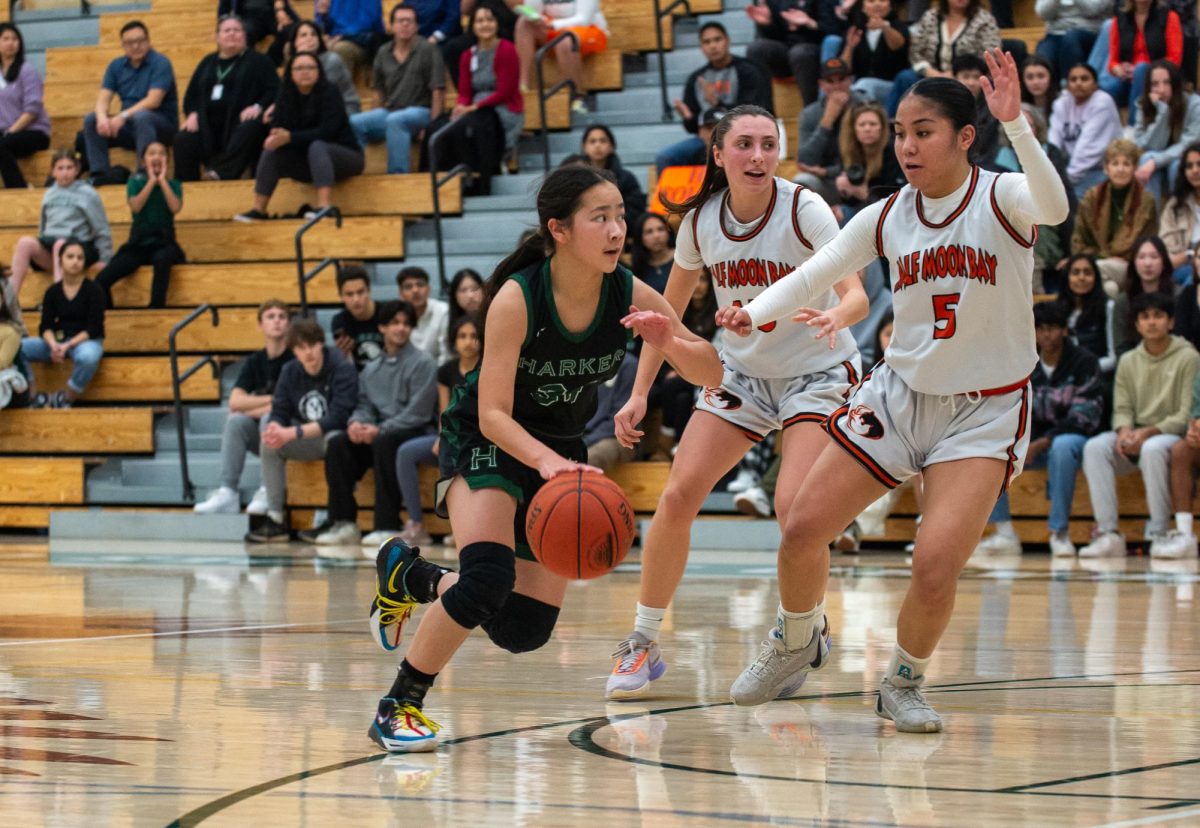























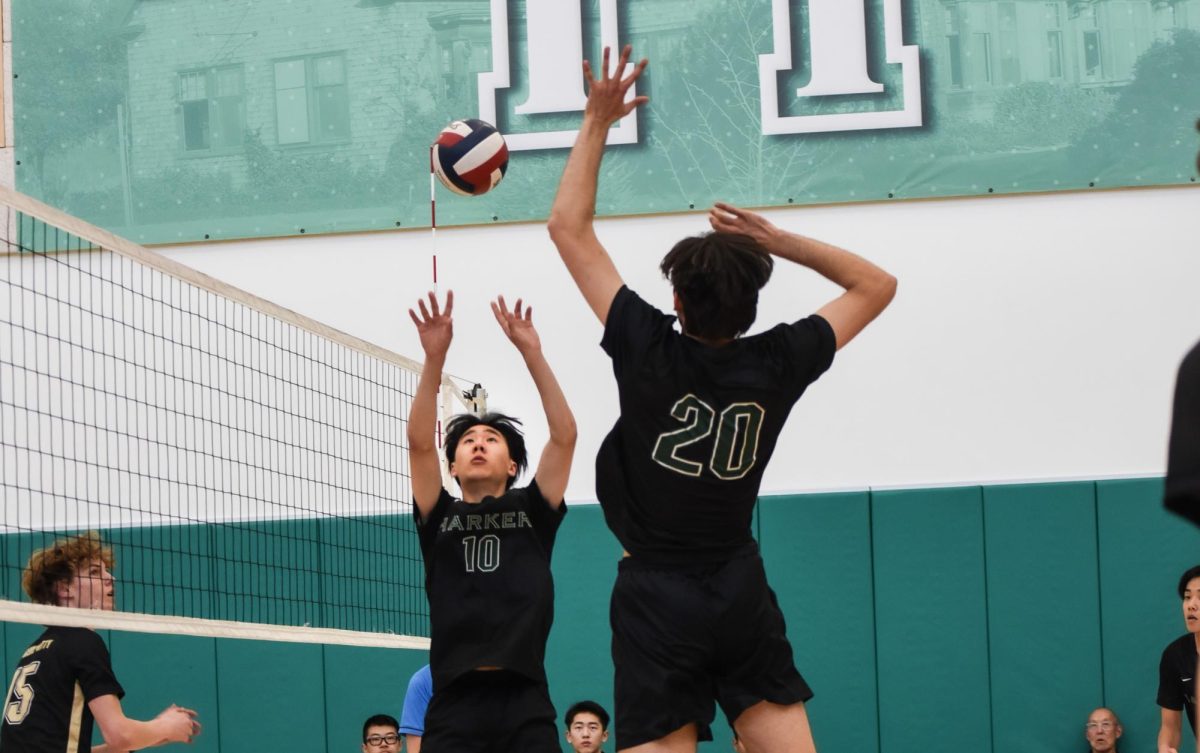
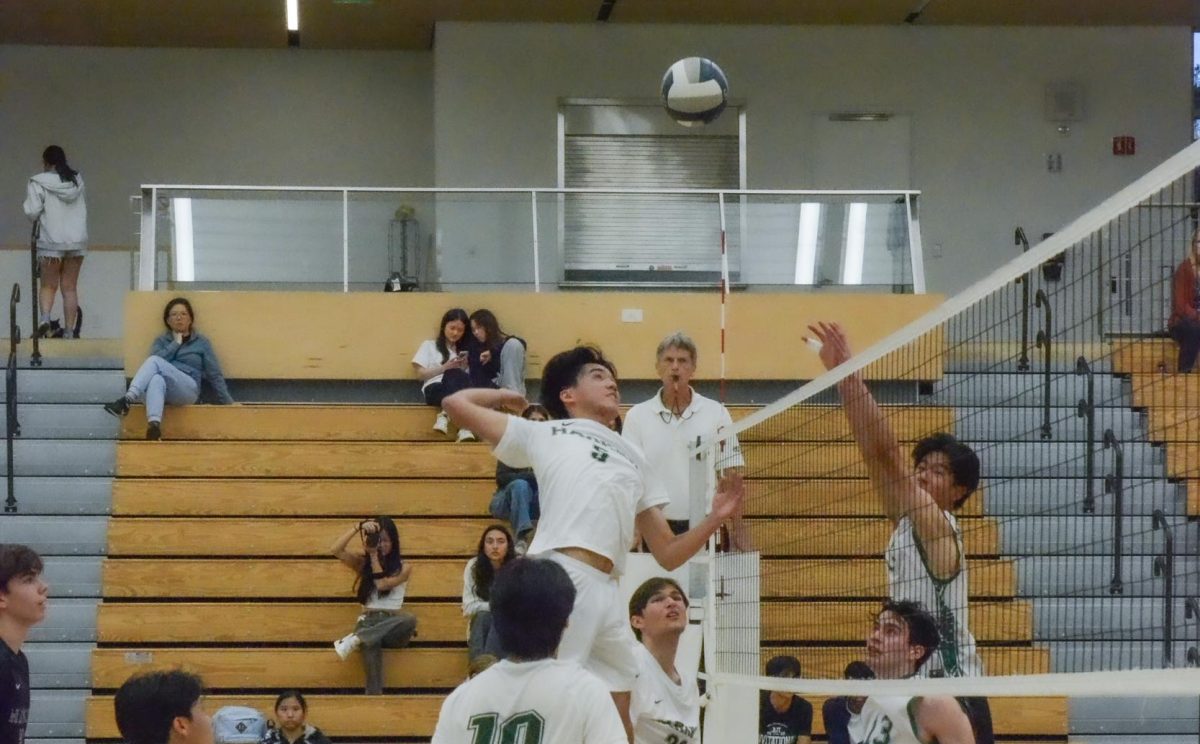

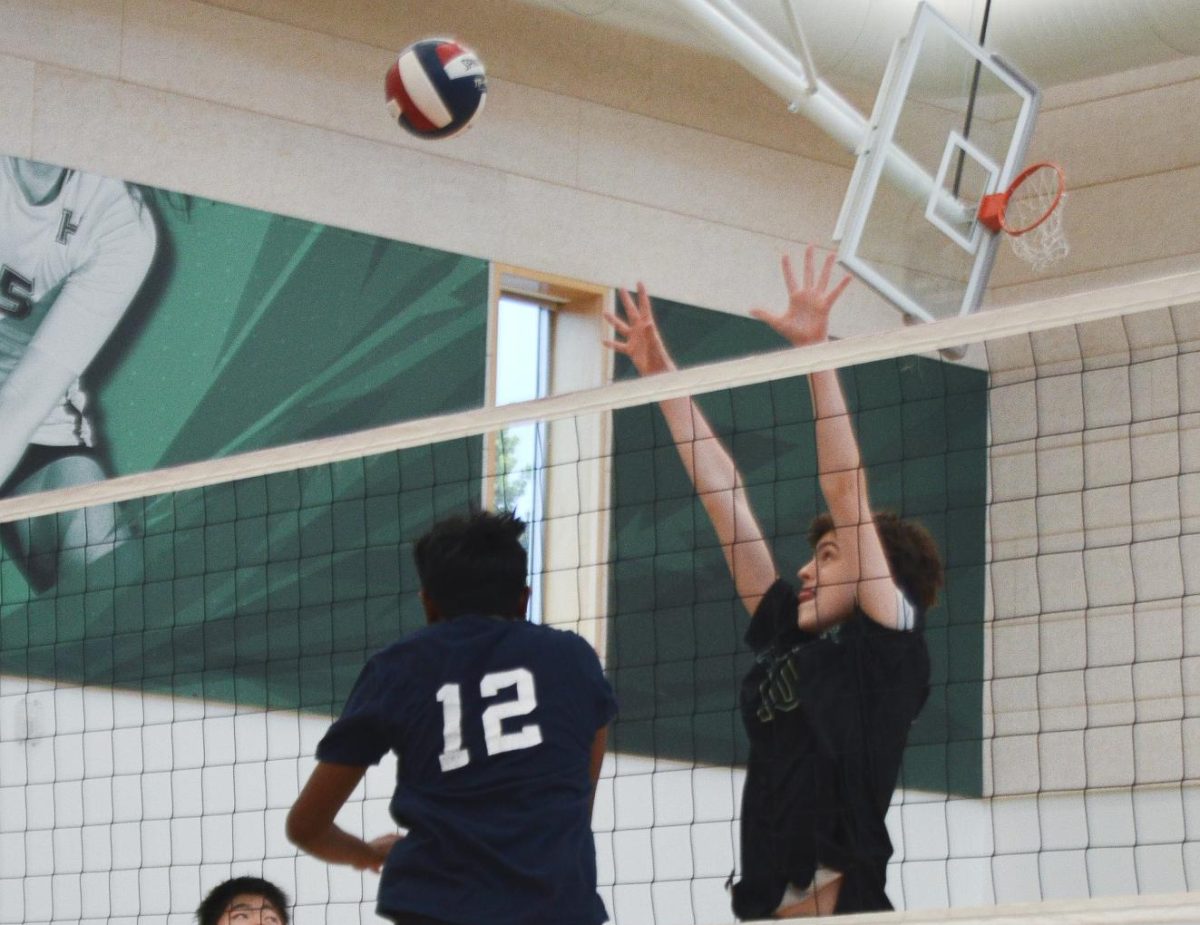
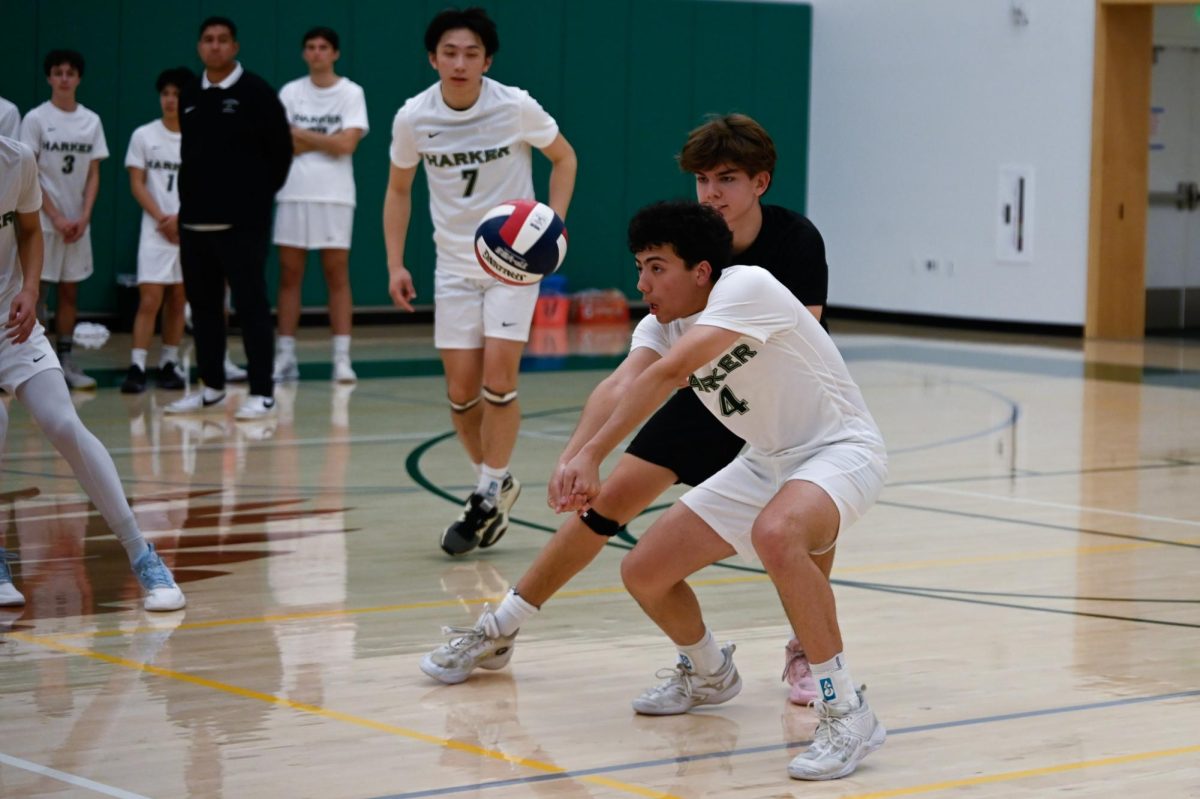




























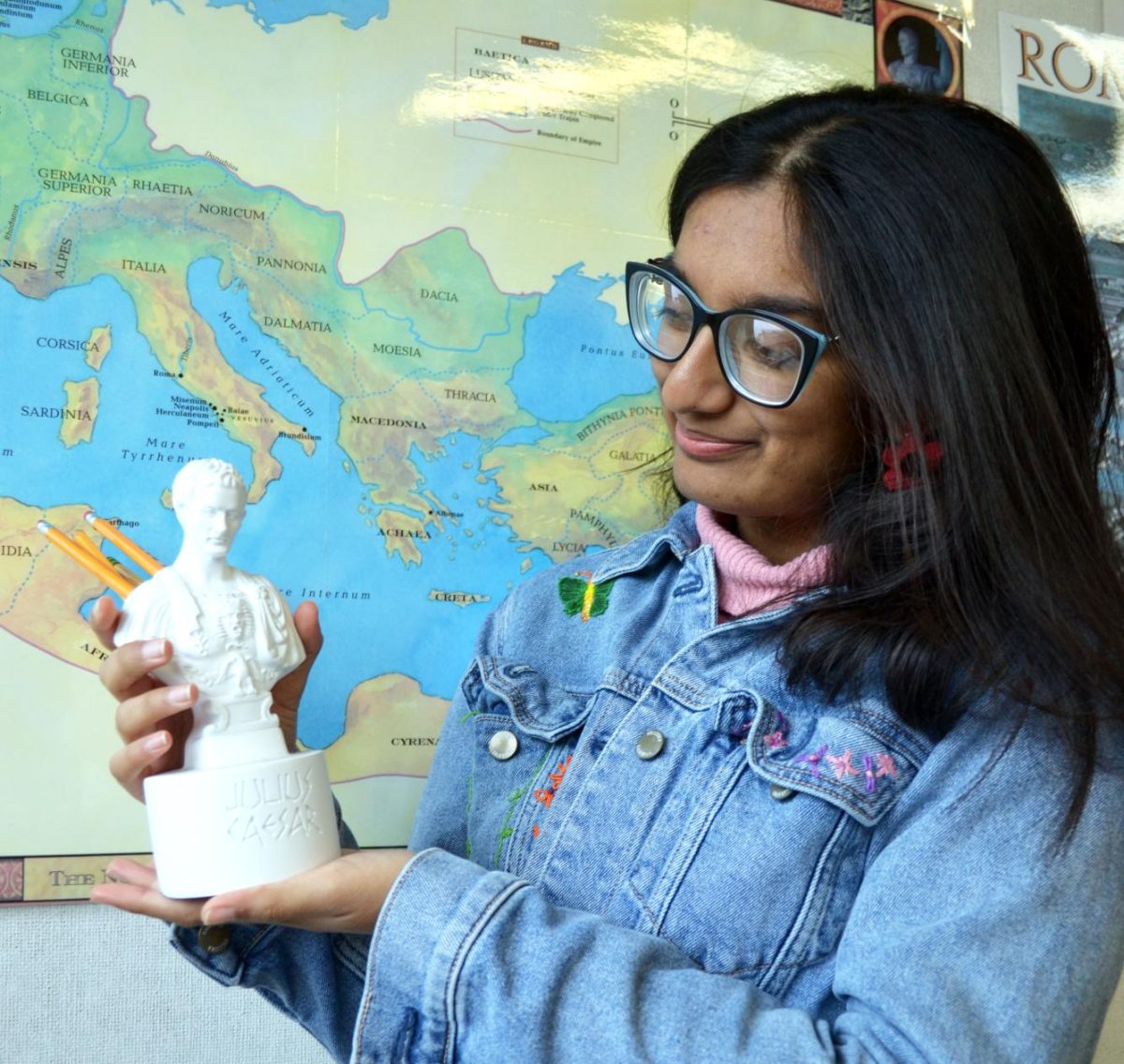
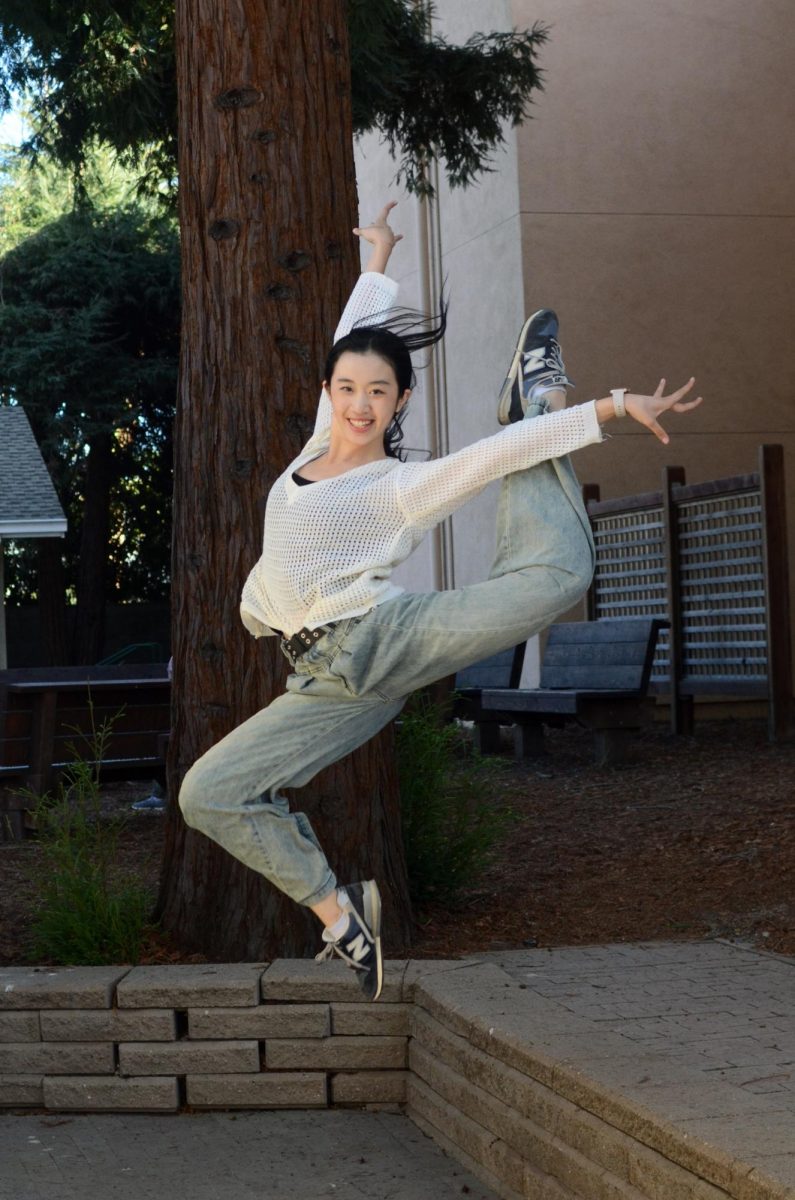
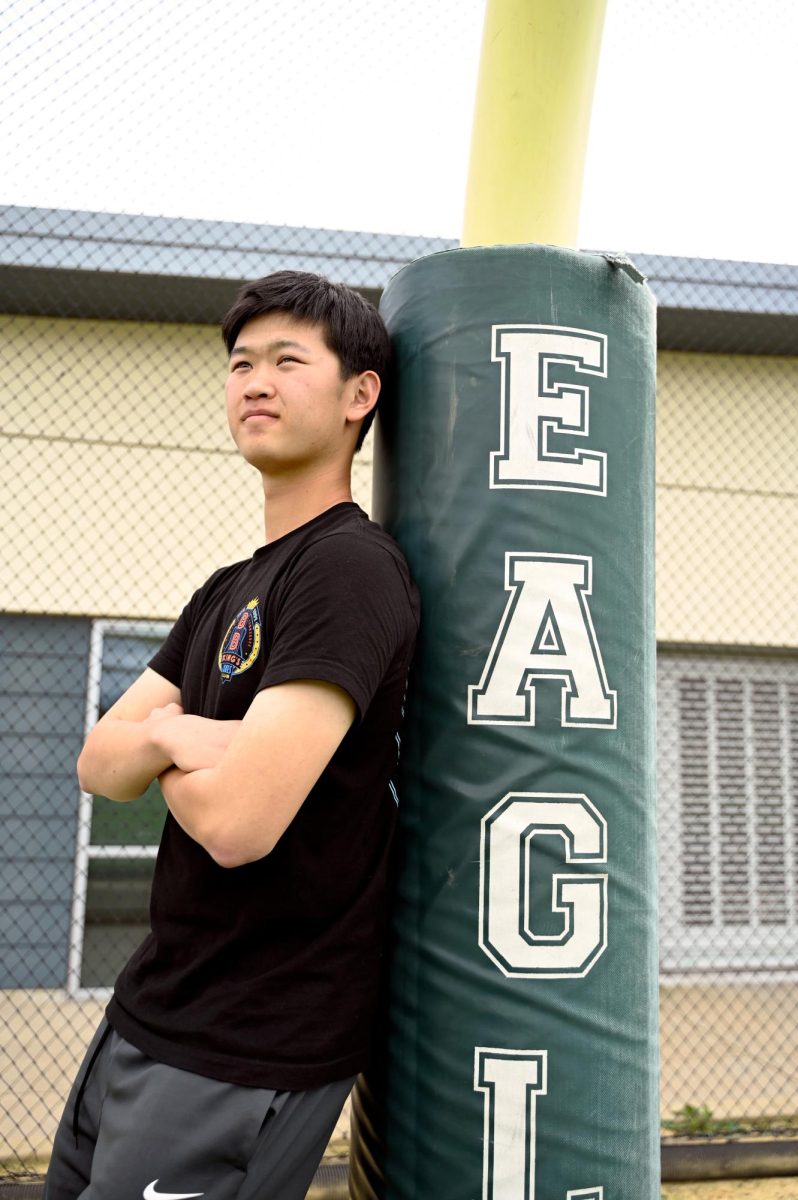
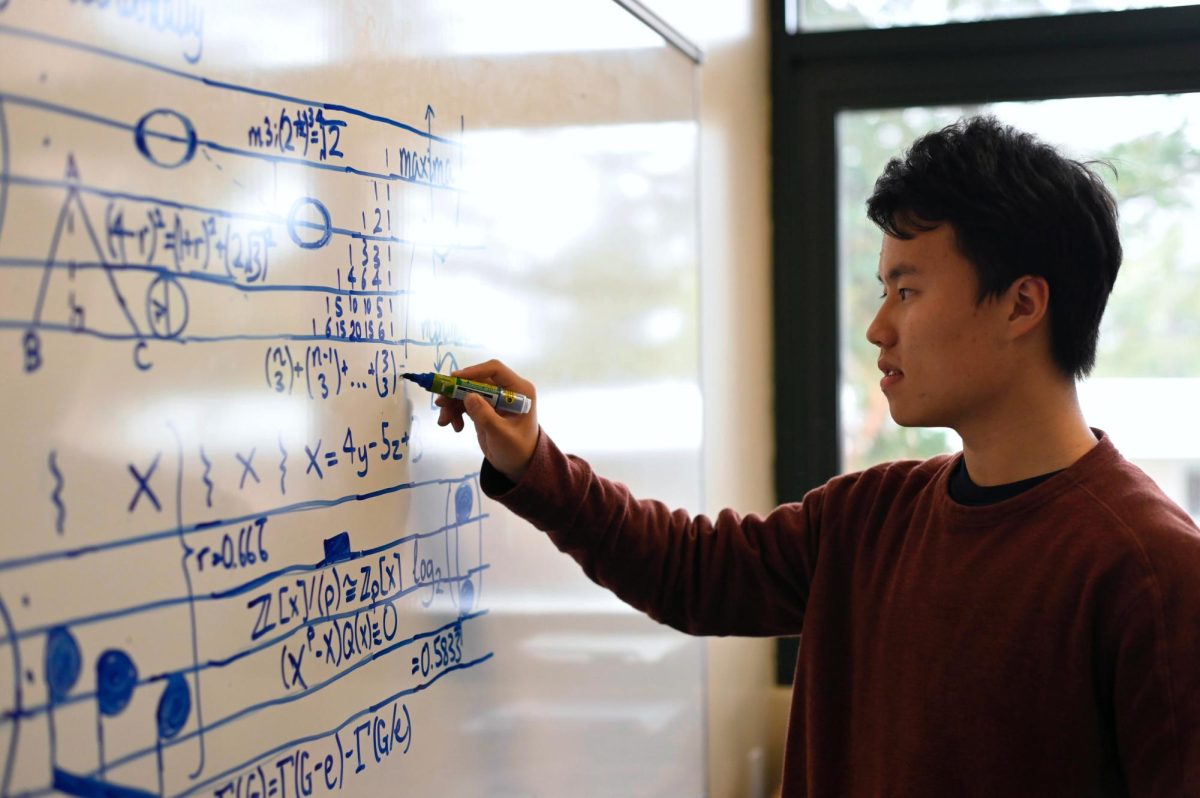
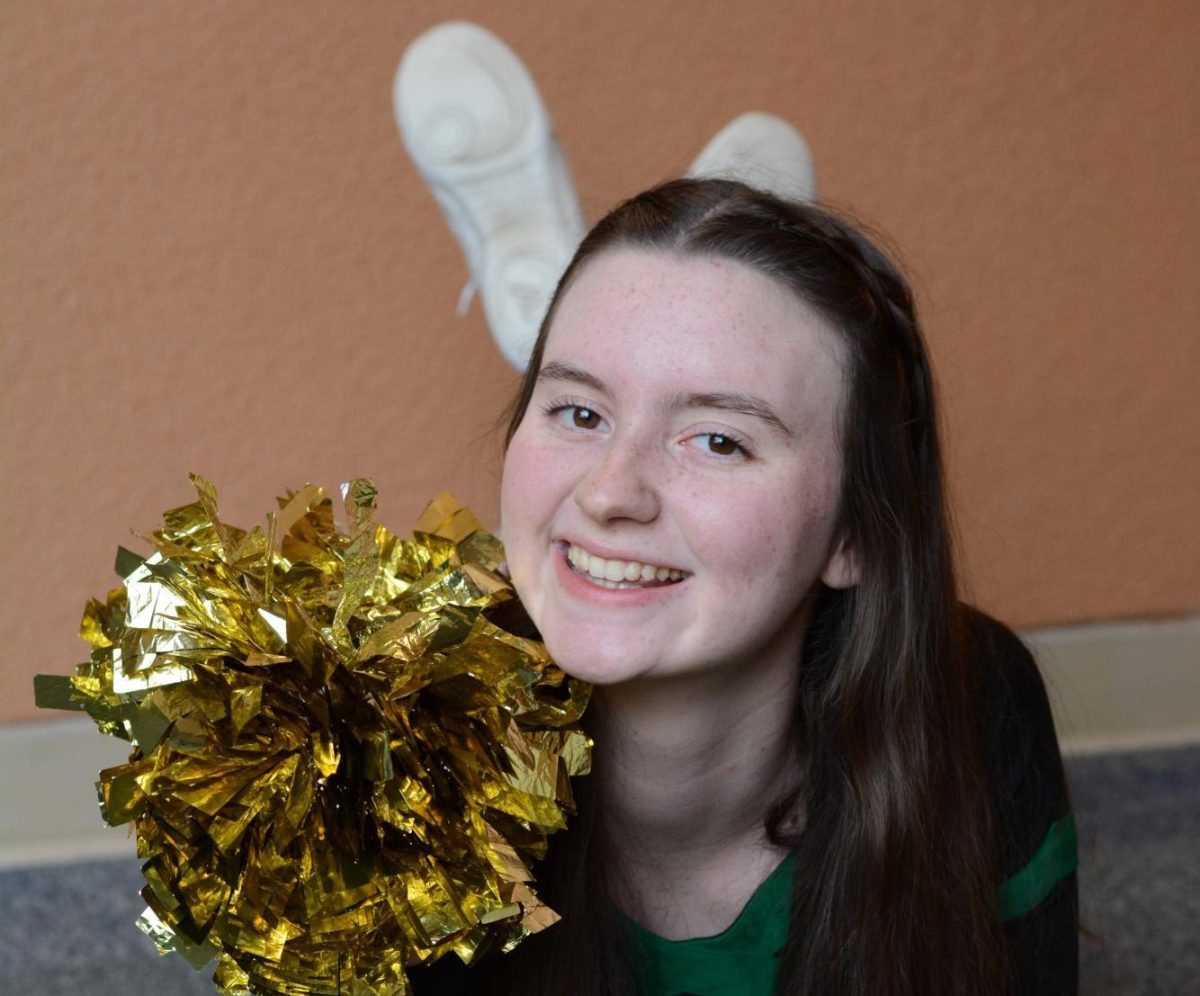








![“[Building nerf blasters] became this outlet of creativity for me that hasnt been matched by anything else. The process [of] making a build complete to your desire is such a painstakingly difficult process, but Ive had to learn from [the skills needed from] soldering to proper painting. Theres so many different options for everything, if you think about it, it exists. The best part is [that] if it doesnt exist, you can build it yourself, Ishaan Parate said.](https://harkeraquila.com/wp-content/uploads/2022/08/DSC_8149-900x604.jpg)


![“Animation just clicked in a way. I had been interested in art, but that felt different. [Animation] felt like it had something behind it, whereas previous things felt surface level. I wasnt making that crazy of things, but just the process of doing it was much more enjoyable, Carter Chadwick (22) said.](https://harkeraquila.com/wp-content/uploads/2022/08/Screen-Shot-2022-08-16-at-9.44.08-AM-900x598.png)


![“When I came into high school, I was ready to be a follower. But DECA was a game changer for me. It helped me overcome my fear of public speaking, and its played such a major role in who Ive become today. To be able to successfully lead a chapter of 150 students, an officer team and be one of the upperclassmen I once really admired is something Im [really] proud of,” Anvitha Tummala (21) said.](https://harkeraquila.com/wp-content/uploads/2021/07/Screen-Shot-2021-07-25-at-9.50.05-AM-900x594.png)



![“[Volleyball has] taught me how to fall correctly, and another thing it taught is that you don’t have to be the best at something to be good at it. If you just hit the ball in a smart way, then it still scores points and you’re good at it. You could be a background player and still make a much bigger impact on the team than you would think,” Anya Gert (’20) said.](https://harkeraquila.com/wp-content/uploads/2020/06/AnnaGert_JinTuan_HoHPhotoEdited-600x900.jpeg)

![“Im not nearly there yet, but [my confidence has] definitely been getting better since I was pretty shy and timid coming into Harker my freshman year. I know that theres a lot of people that are really confident in what they do, and I really admire them. Everyones so driven and that has really pushed me to kind of try to find my own place in high school and be more confident,” Alyssa Huang (’20) said.](https://harkeraquila.com/wp-content/uploads/2020/06/AlyssaHuang_EmilyChen_HoHPhoto-900x749.jpeg)













![“My slogan is ‘slow feet, don’t eat, and I’m hungry.’ You need to run fast to get where you are–you arent going to get those championships if you arent fast,” Angel Cervantes (12) said. “I want to do well in school on my tests and in track and win championships for my team. I live by that, [and] I can do that anywhere: in the classroom or on the field.”](https://harkeraquila.com/wp-content/uploads/2018/06/DSC5146-900x601.jpg)

![“I think getting up in the morning and having a sense of purpose [is exciting]. I think without a certain amount of drive, life is kind of obsolete and mundane, and I think having that every single day is what makes each day unique and kind of makes life exciting,” Neymika Jain (12) said.](https://harkeraquila.com/wp-content/uploads/2017/06/Screen-Shot-2017-06-03-at-4.54.16-PM.png)







